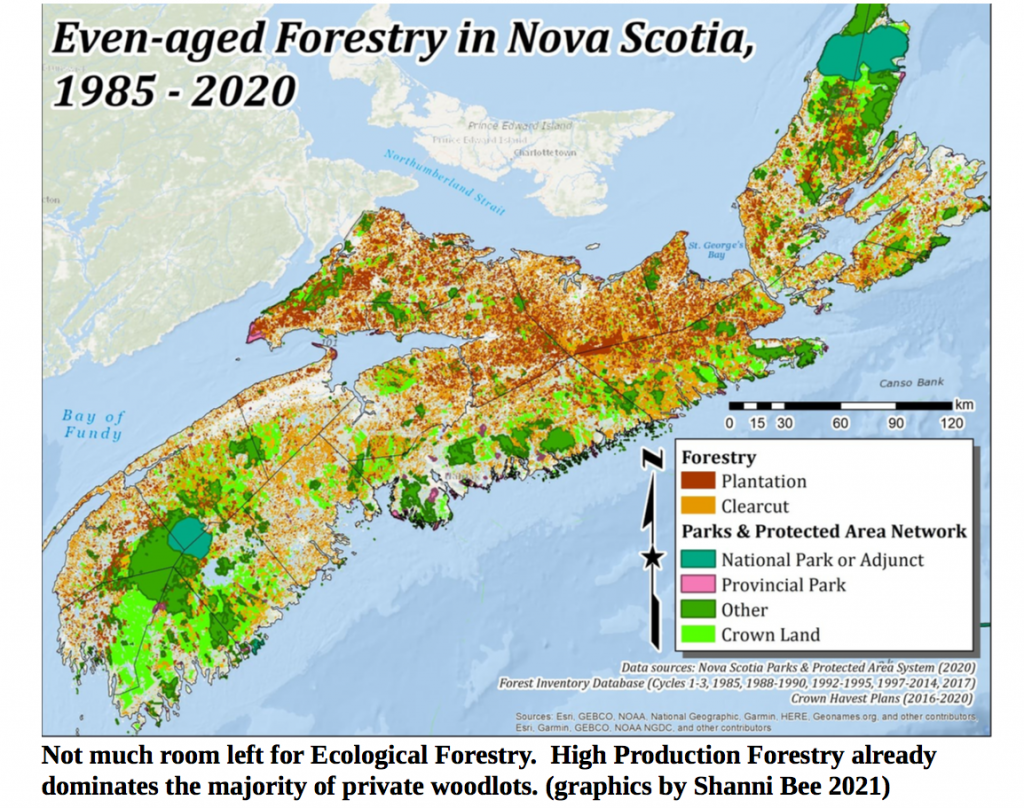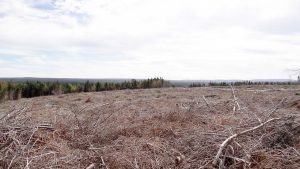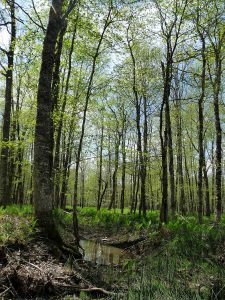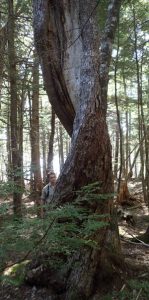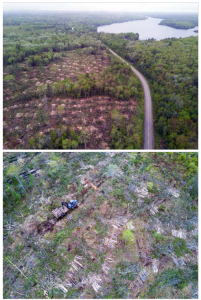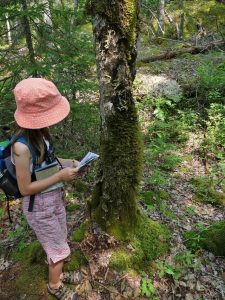
Youngster observing tree moss on a forest outing on a NS Park Event in 2014. We must all be given opportunities to enjoy and contribute to healthy Crown land forests say Addie & Fred Campaigne
And a lot else
Just under a year ago I needed some inspiration to comment on the High Production Forestry Discussion Paper, and it came from Addie and Fred Campaigne who had posted their thoughtful comments on a social media site. (I didn’t know them otherwise.) They gave me permission to post it on NSFN (view post).
Now a year later and for the same reasons, I am again in need of inspiration to comment, this time, on the draft SGEM (the “Silvicultural Guide for the Ecological Matrix” renamed from Forest Management Guide or FMG) which was released on Jan 21, 2021 with comments due by Feb 19, 2021 (view post).
That inspiration again came from comments by Addie & Fred. Their comments on the proposed SGEM illustrate so well the depth of concern, both passionate and reasoned, that so many Nova Scotians have about our natural world, and about our forests in particular. And I especially like that their vision is an inclusive one, it is not “us against them”.
So, say Addie and Fred, carbon-based silviculture is paramount, and a lot more. For example,
Citizen scientists and students must be given a coordinated opportunity to put more eyes on the ground and in the trees to identify possible endangered flora and fauna prior to forest operations. Understanding what makes up a Nova Scotian forest, as well as the various silviculture strategies to manage a carbon-safe ecological wood harvest is paramount. Lands and Forestry must make education a big part of ecological forestry. Letting citizen scientists and students learn about orienteering and what makes up forest ecology would go a long way in public education and relations. All Nova Scotians require more time in our forests. Teaching about the various silviculture techniques and taking students to different stages of recovering forests would be a win-win exercise in public relations and education. Allowing the forest industry to be part of this education would help form stronger future bonds. Nova Scotia’s crown lands belong to everyone, not just the forestry industry. Diversity in species and use of public lands is required.
and from their Conclusion section:
Carbon is life. This guide must support a diverse, carbon rich forest. Canadians want our forests to be a major part of the carbon climate solution and this goal should proactively become a focus of this guide.
Respect nature and learn from indigenous experience.
Learn from indigenous knowledge. Apply that wisdom to forestry practices.
This guide should target public operators and private woodlot owners, as well as municipal, residential and educational audiences.
Do not allow ecological forestry to become an oxymoron.
What a wonderful vision of how things could be. That’s what inspires me. The full document is given below. I have added a few photos and highlighted some of the text to make it easier to read on the web. The unaltered document is available here as a PDF, which is better for printing and reading as a paper document.
Thx, again, Addie and Fred. Shanni too for her map.
———–
19 February 2021 deadline for submissions to ecologicalforestry@novascotia.ca
Forest Management Guide Public Consultation
Nova Scotia Silvicultural Guide for the Ecological Matrix
https://novascotia.ca/natr/consultation/forest-management-guide-public-consultation.asp
Premier Designate Ian Rankin highlighted in his acceptance speech as Nova Scotia’s 29th premier “They (Nova Scotians) want to see us continuing down the path of righting historic wrongs”. This is a hard road to walk since it will require locking horns with opposition parties, powerful industrialists and status quo, the toughest opposition.
Historically, Canadians used heroin for colicky babies, we added it to cough syrups and it actually worked. History and science caught us sealing our food cans with lead and later we added lead to our gas. We used massive quantities of the pesticide DDT and DDT did what it was advertised to do. Our governments removed Indigenous children from the influence of their own culture with residential schools and Canadians let them, believing it was best. Our 28th Premier shut down Northern Pulp; a horrific, racist and environmentally devastating forestry operation, focused directly at indigenous people and their unceded land. Righting historical wrongs is the most honourable and difficult act any politician may ever do.
Our forests are now adding carbon dioxide to our atmosphere. Our forests evolved to do the exact opposite, yet, past governments and industrialists refuse to accept it. Nova Scotia is in a climate emergency because of carbon. Efforts closing coal plants will pale compared to creating healthy forests. Closing a coal plant will reduce the amount of new carbon added to the atmosphere; however, will not remove carbon from the atmosphere. Healthy Acadian forests will. If we stop all further carbon emissions, the planet will still continue to warm. Healthy Acadian forests will help reverse global warming by removing carbon from the atmosphere.
Our favourable response to the Nova Scotia Silvicultural Guide for the Ecological Matrix is enclosed. We strongly believe, that changes detailed in our response, would greatly improve the guide and set the ground work to meet some of the Lahey Reports’ strongest and most popular recommendations.
Nova Scotia Needs Healthy Forests. Addie and Fred Campaigne
Introduction
The approach to responsible forestry detailed in the Nova Scotia Silvicultural Guide for the Ecological Matrix (the guide) is, in numerous ways, far more responsible than High Production Forestry. The guide details how ecological forestry will help nature, diversity and the economy, unlike High Production Forestry where the speed a cut log can be delivered to a mill is paramount. Trees take over a generation to grow and the ecology they create and support takes just as long. The best use of our forests is the most important long-term decision we make. Nova Scotia must realize that the decisions we make now are for our grandchildren and will take a generation to bear fruit. Every forest decision must now be driven by much more than the value of pulp and lumber. These decisions must factor in the amount of atmospheric carbon pollution we create. A simple search of the guide revealed that the word carbon was used only once! It is strange the guide doesn’t embrace carbon since tree growth is well known to forestry science. Carbon sequestration starts with healthy tree growth.
Ecological management of our public forests must be part of our country’s nature based solution to our climate crisis. The federal government has not included our forests in Canada’s Fourth Biennial Report on Climate Change since our forests are now net carbon pollution sources. Similarly, this federal report, agreed to through international commitments, mentions the word forestry only once. There is not much difference between ignoring our largest carbon sink and intentional misinformation. We now know that what is not said may be much more important than what is said. Canada has massive areas covered in forests yet our federal government cannot tell the world that we will use our forests to remove carbon. We now must assumed that the federal government realizes that our forestry operations are making carbon pollution worse. We now must also assume that Nova Scotia’s forestry practices are now making our climate problem worse and ecological forestry must quantitatively demand the following outcome from all ecological forestry operations:
On average for any given area, the carbon sequester next year must be equal to or greater than the carbon sequester this year.
The Guide, Ecology, Carbon and Economics
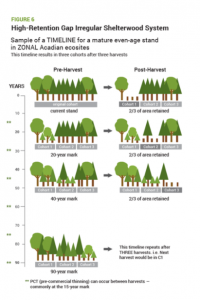
A Figure from L&F’s summary description of the new FMG
It is impossible to separate carbon from ecology. Carbon is a primary component of all known life on Earth, representing approximately 45–50% of all dry biomass . Ecology is the spatial and temporal patterns of the distribution and abundance of life. Ecology’s foundation is life and life is based on carbon. This fact is immutable. Any attempt to ignore carbon and boast about ecology forestry would result in ecological forestry being an oxymoron.
Our oceans and trees are the only immediate and effective vehicle we have to reduce atmospheric carbon. On 26 January 2021, Oxford University released the largest survey of public opinion on climate change ever conducted.
Proudly, Canada ranks at the top, believing our forests must be used to combat atmospheric carbon pollution. If we immediately stopped all anthropological atmospheric carbon pollution, the world would continue to warm at the same rate for a long time. We must use our forests and soils to remove atmospheric carbon. The Nova Scotia government must take responsibility to effectively implement carbon capture with our forests. It was public opinion that closed Northern Pulp.
Nova Scotia has acknowledged that our past forest management was poor. This applies to all of Canada but that does not reduce its importance. Our culpability makes us equally guilty of placing our children in danger. Recent science indicates that our poorly managed forests are emitting carbon-based gases. In other words, poorly managed forests make our climate crisis worse. More carbon is stored in soil than in all the plants and atmosphere combined. As well, soil absorbs approximately 20% of human- generated carbon emissions.
On 27 January 2021, Princeton University scientists identified types of soil bacteria, which, can produce enzymes that break down large carbon-based molecules allowing carbon dioxide to escape. They now believe that carbon dioxide can escape the soil much faster than previously thought. Approximately 94% of sugar’s mass is carbon and oxygen. We know that in a healthy forest larger trees support smaller trees by passing them complex sugar molecules. We must now assume that removal of smaller trees with a silviculture procedure may result in a build up of complex sugars in the soil. This coupled with Princeton’s publication leads to a viable condition for carbon gases to escape from the soil, aggravating our current atmospheric dilemma. Science is complicated; however in this case, all forestry must now consider that if the forest floor is disturbed, carbon will be released. The guide must demonstrate that science is advancing and emphasize that until the “science is in”, caution must prevail.
Scientific research investigating the dynamics of atmospheric carbon with trees and soils is very well funded. New papers are continuously increasing our knowledge of the balance between atmospheric carbon and our forests. On 8 February 2021, University of West Virginia biologists uncover an unexpected role how our forests interact with climate change. Analysis using carbon and oxygen isotopes in tree rings from 1901 to 2015 shows that trees around the world are consuming more carbon dioxide than previously reported. This makes forests even more important in regulating the Earth’s atmosphere and forever shift how we think about climate change.
The guide acknowledges climate change and identifies serious problems our forests face. In addition, it anticipates that some important tree species will not perform well in a warming climate. The guide also acknowledges that a warming climate would exacerbate the destruction of our forest through increased natural disturbances such as wind, insects and disease. Unfortunately, it does not proactively engage our climate crisis. Instead, it will leave these problems to “future research”. This statement may be interpreted as “let the next generation handle it”. Statements like this reinforce ecological forestry’s oxymoronic image, which must be avoided.
Clear-cutting is now strongly suspected in releasing atmospheric carbon pollution, no different than burning fossil fuels at our power plants or in our cars. Currently, our power plants and other carbon polluters must pay a carbon offset to reconcile their pollution. The guide cannot ignore this approach and must start accounting for carbon. We may not be able to confidently estimate a prescription’s effect on soil carbon; however, we know the number of trees removed and their carbon mass. We also know that our soil is capable of storing vast carbon reserves. Give treatment priority to large, deep- rooted species to increase the carbon sink volume where deep soils are found.
This guide must support the strong science and advanced mathematical models that now predict significant global warming. The federal government has stated that Canada on average is now 2°C warmer than it was half a century ago. The guide must modify procedures and decision points that will favour trees that are projected to be more resilient in a warming climate. This is especially true if 30+ years of growth will be required before the next treatment or harvest. Red oak, black cherry or sugar maple would always take priority over spruce or fir in long-term treatment considerations. White, Black or Norwegian spruce and eastern fir will not thrive in a warming climate and should be discouraged.
As warming continues, ecology will try to adapt and hopefully succeed. We are in new territory. At no time in history has the planet warmed this rapidly. Historical warming has caused numerous mass extinctions in the past; however, these occurred over millions of years, never in a couple hundred years as we are currently experiencing. We should expect some boreal forests species to show signs of vigour; however, science now believes that will be transitory. Warming is now happening so fast that consideration to encourage more broad leaf non-native species currently found in Maine may speed healthy forest change. White oak, for example, is an extremely valuable and dense (high carbon) species. It has a large root system and produces excellent rot-resistant wood. Increasing the percentage of broad-leaf hardwoods will also reduce forest fire severity.
The guide only focuses on the value of cut logs. We are now experiencing a mass die-off of insects and migratory birds. Migratory birds feed their young with insects of all forms. Black cherry and red oak are insect magnets, supporting numerous species. The health of insects and birds are major ecological components of our forests and all treated stands must maximize this ecology. The value of a saw log is not part of ecology. Oak and cherry have enormous ecological and economic values that must be maximized. Once an oak, cherry or maple has passed its period of maximum growth rate, the lumber is extremely valuable and the carbon captured would be locked up for another 100+ years in beautiful floors, laminate wood products and furniture.
The guide must identify all native tree species that demonstrate high carbon sequestration value. It must give those species immediate priority for silviculture treatment to help protect, manage and restore our forests. This nature-based solution would drive reforestation efforts with the Acadian forest’s best carbon sinks. The native species that are expected to thrive and sequester the most carbon must be given continuous public attention. Nova Scotia’s nurseries must be encouraged, through the tax system, to produce native species that will maximize carbon sequestration. Similarly, sales tax on all Nova Scotia produced native species must be eliminated. The Nova Scotia government must also lobby the federal government to reciprocate on the GST and encourage residential and municipal planting of native trees. This guide must be revised to reflect the best direction for our combined forest and children’s future.
The guide barely mentions the importance of riparian forests. River ecology is one of the most important zones in our forests and supports a massive diversity of life. Very large, natural forested areas on both sides of our streams must be defined, completely protected and enforced. Areas that support mainland moose must extend the protection distance. A minimum distance for all waterways must be no less than 60 metres and must be legally binding. Effective legal protection for species at risk using this type of habitat must be publicly demonstrated. Similar protections must apply to other wetland habitats, such as vernal pools and beaver ponds.
Our federal government is drastically escalating the value of carbon as a result of the alarming science now unfolding. We are facing a make-or-break scenario for our future. We must have significant carbon-reducing procedures in place by 2030 (nine years from now) or else miss a critical 1.5°C climate target. In nine years, a red oak is only beginning to show a measurable rate in annual carbon gain. This guide must do so much more than support saw logs.
This guide must also be made available to our private woodlot owners so they may take advantage of officially sanctioned, carbon based silviculture procedures. The woodlot owners would be able to use this guide to produce the best carbon-sink properties. If the government continues to deny carbon offset values to our responsible woodlot owners, then they would be in a great, government backed, position to seek external offset sponsors. In 2015 IKEA purchased 83,000 acres woodland in northeastern Romania in order to help create a sustainable wood supply. IKEA has now purchased hundreds of thousands of acres of woodland in the US for both a sustainable wood supply and carbon offset use. Demand for carbon offsets from worldwide carbon polluters will increase as the climate worsens and efforts to mitigate climate change increase.
The federal government has given cap and trade provinces an enormous gift, on which Nova Scotia can now capitalize. In 2022, carbon will be worth $50/tonne. This will increase linearly by $15/tonne for the next eight years, finally yielding $170/tonne in 2030. A healthy Nova Scotia forest will conservatively sequester 500 kg/ha of carbon in trees alone. Carbon-healthy soil will increase this reserve even more; however, science currently cannot confidently estimate a value that any finance department would use. The federal government wants us to make money through carbon financing. This guide must be emended to reflect the best ecological forestry techniques and current science to maximize atmospheric carbon sequestration.
Nova Scotia’s crown land currently covers an area of 1,825,000 ha. If all our publicly owned lands were actively growing healthy trees, then in 2030, they would annually be worth: 1,825,000 ha * 0.5 tonnes/ha * 170 $/tonne = $155,125,000, i.e. $155 million dollars annually by doing nothing but grow. This is not an insignificant sum. Nova Scotia must responsibly come to economic terms with the forest industry. We must move ahead in the manner that is best for our forests and our children’s future. Above all, Nova Scotia needs healthy forests.
At this time, soil carbon would not enter in the equation. Of course all woodlot owners (including public owners) would be required to understand that as soil carbon science improves, the gas released would be the owners’ responsibilities to offset. However, as stated earlier, the soil contains more carbon than all the trees and the atmosphere combined. Healthy woodlots would expect a net positive soil carbon sink, further increasing their annual incomes.
An ecologically managed forest must adapt to climate change while maintaining or increasing carbon reserves. For any defined area, the carbon captured and stored by trees next year must be equal to or greater than the carbon captured this year. This gain in our trees’ carbon growth would determine the ecological harvest limit for all managed areas. If this simple rule is applied, our forests will increase tree and soil carbon, our harvests will be defined and justified, and atmospheric carbon will be reduced. This guide must be driven to maximize carbon sequestration by trees and soils. This will also go a long way in meeting the Lahey requirement to allow carbon offsets.
An ecological approach to forestry must also improve the natural species diversity of our Acadian forests. Various bushes and trees may not have an economic value, yet they will still require planting (or not being removed in the first place) so that an ecological gain is realized.
Accountability
 To ensure ecological forestry, all of Nova Scotia’s public and private forests must financially account for their carbon masses. Carbon is our new currency and all forest practices must be carbon responsible. The carbon mass removed through thinning and wood destined for pulp must be considered a deficit. Wood destined for new building material would be part of the planned harvest that resulted from an increase in carbon reserves. Net annual carbon deficits must be offset annually through our existing cap and trade system. Any forest procedure employing radical silviculture techniques based on some percentage of a clear cut must be handled as an interest-bearing loan. This loan must account for the future value of lost carbon capture. Carbon offsets will be required annually until the forest finally generates the initial carbon reserve along with the future carbon value it would have sequestered after cutting. Rigid financial management would severely limit radical silviculture techniques and terminate High Production Forestry. Above all, everyone must accept that until we solve our current climate crisis, carbon will escalate in value each year. We must treat and manage carbon (not fibre nor lumber) as the prime forest asset. If we manage forests’ carbon assets (trees and soil) properly, then a healthy forest ecology will ensue.
To ensure ecological forestry, all of Nova Scotia’s public and private forests must financially account for their carbon masses. Carbon is our new currency and all forest practices must be carbon responsible. The carbon mass removed through thinning and wood destined for pulp must be considered a deficit. Wood destined for new building material would be part of the planned harvest that resulted from an increase in carbon reserves. Net annual carbon deficits must be offset annually through our existing cap and trade system. Any forest procedure employing radical silviculture techniques based on some percentage of a clear cut must be handled as an interest-bearing loan. This loan must account for the future value of lost carbon capture. Carbon offsets will be required annually until the forest finally generates the initial carbon reserve along with the future carbon value it would have sequestered after cutting. Rigid financial management would severely limit radical silviculture techniques and terminate High Production Forestry. Above all, everyone must accept that until we solve our current climate crisis, carbon will escalate in value each year. We must treat and manage carbon (not fibre nor lumber) as the prime forest asset. If we manage forests’ carbon assets (trees and soil) properly, then a healthy forest ecology will ensue.
According to Bob Dylan, “we live in a political world”. Nova Scotia must never be seen politically as carbon irresponsible in its forestry practices. We do not want to suffer a devastating financial loss the way Alberta’s Keystone Pipeline went the very day that the new US president took power. We should expect the USA and Europe to become extremely carbon responsible by adopting an aggressive escalating carbon price, forcing the world to fall in line through modified trade agreements. We experienced the trauma that President Trump inflicted by discarding our existing free trade agreement, just to demonstrate his power and the international control he had. The USA is that powerful and President Biden has now fired a warning shot over our bow. Nobody wants to be told what to do, so the Nova Scotia government must start leading by using financially managed carbon assets and only responsible forest practices. Trade agreements with the USA and other countries will become more difficult if we do not manage our forest carbon assets.
Politics in the USA is very different from that in Canada. President Biden has exactly two years to demonstrate a significant “America First” economic gain before the next round of US elections. Simply curing SARS CoV-2 in the US will not help him; it must also be financial. The Obama presidency, in which Joe Biden was vice president, wrestled for years with Canada over softwood lumber. The US currently does not use large amounts of public land for forestry and objects to Canada doing so. Socialistic ideologies are not an easy sell in the USA. We must prepare for another softwood lumber assault, but this time, carbon control and greatly reduced harvests will be sought instead of stumpage fees.
 The Journal of Forestry published Forest Management for Carbon Sequestration and Climate Adaptation on behalf of the Society of American Foresters 2019, available from the United States Department of Agriculture at https://srs.fs.usda.gov/pubs/59214. This science-based publication, released during the climate denying Trump administration, resonates the direction US forestry will tout under the Biden administration. This guide must clearly detail how ecological forestry will sequester carbon. Furthermore, this guide must highlight silviculture treatments designed to maximize carbon sequestration. Politically, the guide must conclusively demonstrate that carbon sequestration is an important outcome of ecological forestry.
The Journal of Forestry published Forest Management for Carbon Sequestration and Climate Adaptation on behalf of the Society of American Foresters 2019, available from the United States Department of Agriculture at https://srs.fs.usda.gov/pubs/59214. This science-based publication, released during the climate denying Trump administration, resonates the direction US forestry will tout under the Biden administration. This guide must clearly detail how ecological forestry will sequester carbon. Furthermore, this guide must highlight silviculture treatments designed to maximize carbon sequestration. Politically, the guide must conclusively demonstrate that carbon sequestration is an important outcome of ecological forestry.
Proponents of our current forestry practices must recognize that steel building studs are in direct competition with spruce studs. Our building industry can flourish with steel studs resulting in a greatly reduced demand for spruce studs. The acceptance of steel studs for environmentally friendly structural components and reduced labour benefits, is growing. A steel industry led by Nova Scotia, which manufactured steel studs using recycled steel and powered by renewable energy, would be a win for all. This benefit would extend to our forest’s ecological and monetary carbon value. Initially, recycled steel could be supplied with the massive quantity of old derelict cars littering our rural properties. Each logging truck would replace their hydraulic claw with an electromagnet and clean up. Nova Scotia’s forest industry desperately requires greener competition and a greatly reduced harvest. We must accept that our tiny province can no longer ecologically and environmentally support a pulp mill, numerous major sawmills and a couple of bio-fuel power plants. That’s simply not feasible for Canada’s second smallest province, which has a total population less than a million.
Historically, the Department of Lands and Forestry has never been very honest, forthcoming or accountable to the public. Politicians have continually injected personnel loyal to the forest industry into senior positions. This “Trumpian” style leadership has eroded public trust. Past practices of hiding repulsive forest operations from the public by shielding harvests with thin natural visual barriers or cuts high on mountains have worked in the past. The Department of Lands and Forestry has been successful in the past, keeping the Nova Scotia public fat, dumb and happy.
The complete lack of government accountability in regards to our public forests is a severe shortcoming of the guide. The Nova Scotia Department of Finance must be fiscally responsible to all Nova Scotians for carbon-wealth accountability. Lands and Forestry must be required to prove, through high-resolution aerial surveys, that our “ecologically managed” forests are, in fact, what the department claims. This accounting must also apply equally to each leg of the forestry triad detailed in the Lahey report.
Aerial high-resolution photography and before and after comparisons of all logging operations on public land must be a requirement of all forest contractors operating in Nova Scotia. This operation must be contractually demanded. Preferably, it would be financially borne by the contractors. These surveys must be well planned and executed in seasons that will maximize the probability of species identification. Aerial drones capable of executing a predetermined flight plan would be used. The flight plan would completely cover the treatment area ensuring maximum detail for identification purposes. The flight plan would be controlled from a secure Lands and Forestry site with restricted write access. The drone would have a minimum equipment payload comprising of high-resolution camera(s), accurate GPS with altitude, temperature and accurate date-time support. Infrared photography would allow opportunistic mammal and bird surveys. However, restricted public access would be required to reduce the probability of poaching. All cameras would need resolution and light spectrum sensitivity sufficient to identify tree species and estimate carbon mass. Lands and Forestry would be responsible for defining the technical requirements for all equipment. The complete technical specifications must be made public, enabling free scrutiny by scientists, engineers and mathematicians that make Nova Scotia their home.
A rigid accountability standard will permit ecological forestry operations to adapt to evolving science. Furthermore, the complete lack of carbon basics in the guide must be countered with accurate photographic aerial surveys. This will serve as raw data for new science, engineering and technology and provide conclusive proof forest contractors are doing what they were contracted to do. Ecological forestry is an order of magnitude more complicated than High Production Forestry clear cuts and the spraying of glyphosate-based herbicides. This accountability and data collection would apply to all forest triad groups and to logging road construction and maintenance operations, even if the road passes through private property.
Public read-only access to photographic data must be permitted to end the “fat dumb and happy” syndrome. Free and open data access will let the public develop its own homegrown algorithms progressing forestry science and business. It will also ease specialized outsourced science research. This open public interaction will support technology and greatly increase trust. Adding summer surveys five years after the treatment may go far gaining public trust and support.
Photographic based artificial intelligence (AI) has grown by leaps and bounds over the last ten years. Application of AI would enable effective carbon and ecological monitoring with minimal human resource expense. AI is available that is tuned for forestry operations. Don’t expect free off the shelf solutions, but expect public help if open photographic data access is always available. Businesses will benefit from this data. If you plant the seed, it will grow.
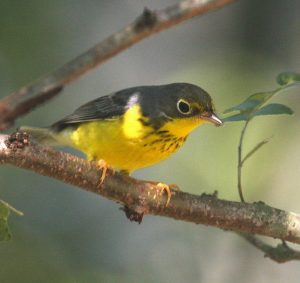
Canada Warbler. Photo by Emmett Hume
Citizen scientists and students must be given a coordinated opportunity to put more eyes on the ground and in the trees to identify possible endangered flora and fauna prior to forest operations. Understanding what makes up a Nova Scotian forest, as well as the various silviculture strategies to manage a carbon-safe ecological wood harvest is paramount. Lands and Forestry must make education a big part of ecological forestry. Letting citizen scientists and students learn about orienteering and what makes up forest ecology would go a long way in public education and relations. All Nova Scotians require more time in our forests. Teaching about the various silviculture techniques and taking students to different stages of recovering forests would be a win-win exercise in public relations and education. Allowing the forest industry to be part of this education would help form stronger future bonds. Nova Scotia’s crown lands belong to everyone, not just the forestry industry. Diversity in species and use of public lands is required.
Conclusions
Carbon is life. This guide must support a diverse, carbon rich forest. Canadians want our forests to be a major part of the carbon climate solution and this goal should proactively become a focus of this guide.
 Respect nature and learn from indigenous experience. Learn from indigenous knowledge. Apply that wisdom to forestry practices.
Respect nature and learn from indigenous experience. Learn from indigenous knowledge. Apply that wisdom to forestry practices.
This guide should target public operators and private woodlot owners, as well as municipal, residential and educational audiences.
Do not allow ecological forestry to become an oxymoron.
The time is perfect to transform ecological forestry by emphasizing carbon sequestration. Canada has committed to resolve our climate problem by 2050, thirty years from now. Many treatments detailed in this guide require thirty years. In thirty years healthy, ecologically managed forests would be beginning their maximum sustained growth periods and pulling the maximum amount of carbon out of the atmosphere. The government of Nova Scotia must start ecological forestry now and incorporate carbon sequestration for our future.
This guide is a direct result of implementing the Lahey Report and High Production Forestry has proven that the Lahey report is seriously flawed. Simple Internet searches reveal graphic images of numerous Nova Scotian clear-cuts. This guide has produced an unintentional yet extremely gratifying result; it has conclusively demonstrated how detrimental High Production Forestry really is.
Ecological forestry must refocus our forest’s financial dependence from softwood lumber to high value hardwoods and carbon sequestration. Softwood lumber production, from all woodlands, both public and private should be limited to the Nova Scotia market only.
Disturbing our forest floors will result in releasing carbon-based gases into the atmosphere. This guide must emphasize this fact and make every effort to reduce soil gases by taking a minimal approach to all silviculture treatments.
Nova Scotia must dramatically increase concentrations of red oak and black cherry to offset the decline of insects and migratory birds. Similarly, the guide must focus on the enhancement of habitat for mainland moose and all endangered species. This guide should detail what and where these treatments should be applied, leaving no doubt that ecological forestry is not an oxymoron.
On a provincial level, ecological forestry must consider the introduction of white oak and other broad- leaf hardwoods native to Maine for climate resiliency purposes. This guide should detail best practices for a successful introduction.
This guide should develop techniques to reduce the boreal zone species concentration while maintaining a healthy Acadian forest balance using mid-century scientific climate predictions. We must realize that a warming climate would worsen summer drought conditions, increasing the intensity and probability of wildfires. A greater diversity and concentration of broad-leaf hardwoods, and a reduction of boreal evergreens would serve to greatly enhance our forest’s natural fire and insect protection.
Given any defined area, the carbon sequester next year must be equal to or greater than the carbon sequester this year. A year over year gain in carbon capture would determine the ecological harvest limit for all managed areas. Forest based carbon science research is now well funded. Nova Scotia will be forced to deal with our current soil based carbon pollution in the very near future. The Department of Lands and Forestry should clean up its image and get a grip on it now; don’t be penalized later like a lagging student. Bring all known aspects of soil and tree carbon into ecological forestry and this guide. As more science is discovered, the guide can be electronically amended without republishing on paper. Do not turn ecological forestry into an oxymoron.
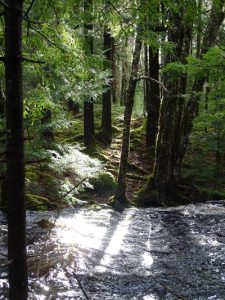 The ecology of streams and rivers is one of the most important aspects of our forests. Riparian zones keep our streams clean and support an enormous diversity of life, including human life. A minimum buffer of 60 metres on both sides of all rivers and streams must be used to preserve riparian forests. This critical protection must be extensively detailed in the guide and enforced in all forest operations.
The ecology of streams and rivers is one of the most important aspects of our forests. Riparian zones keep our streams clean and support an enormous diversity of life, including human life. A minimum buffer of 60 metres on both sides of all rivers and streams must be used to preserve riparian forests. This critical protection must be extensively detailed in the guide and enforced in all forest operations.
Nova Scotia has faced numerous problems disposing of derelict cars and old ships. It’s time to lobby the steel industry, allocate several hectares of industrial land, supply renewable energy and recycle this waste steel into construction studs and other building products, lessening the demand for softwood. This ecological forestry guide is the right vehicle to initiate and promote the forest changes required for the 21st century.
Along with carbon, this guide ignored accountability. Accountability is the only tool the government has to prove we are implementing the correct ecological approach to forestry changes demanded in the Lahey Report. Lands and Forestry let the public down with its release of High Production Forestry. Don’t let ecological forestry generate another public disappointment. Ignoring carbon and not building in strong accountability would be public negligence. The guide must be accountable for all of its forestry treatments and the public has a right to see the results.
Crystal balls are not supported by science; however, the new US administration is now driven by fighting climate change. President Biden has shown his hand with the demise of Alberta’s XL pipeline. The US Forestry Service is being proactive by publicly releasing several important scientific papers that focus on using forests to sequester carbon. The Canadian public wants responsible forest management that will mitigate the climate crisis. Yet all levels of government are seriously guilty of allowing our forestry practices to continue polluting our atmosphere with carbon. Expect the USA to demand significant forest carbon capture from Canada. Our Acadian forests are a major component of Canada’s forest system. Expect the world to demand that Canada ends its current forestry-based polluting operations. Use ecological forestry and this guide to lead the way to capitalize on carbon sequestration and see it through.
High-resolution before and after aerial photography will allow us to apply future science in order to evaluate past forest operations. Evolving silviculture techniques will require data for simulations and development. Strong accountability in ecological forestry through aerial photography will stimulate new science. High-resolution photography would also assist our private woodlot owners, guaranteeing that their operations are capable of supplying carbon offsets. These offsets are required by the Lahey report, our wood lot owners want them and our province needs them to help financially buffer major changes to Nova Scotia’s forest industry.
Pressure to increase carbon sequestration will grow as financial carbon markets mature. Open and public accountability of ecological forestry would be neither difficult nor expensive and would go a long way helping science. Ecological forestry must earn carbon wealth and this guide must detail the best practices. The Lahey report must be incorporated honestly in a way that reflects Lahey’s ultimate conclusion, the need to protect biodiversity.
Nova Scotia Needs Healthy Forests
Addie and Fred Campaigne

